British
Home and Hospital
for Incurables
for Incurables
Crown Lane, Streatham, SW16 3JB
Medical
dates:
Medical
character:
Long-term care
The British Home and Hospital
for Incurables was founded in 1861 by a group of philanthropists who
had broken away from the Board of Management of the Hospital for Incurables in Putney
House, Richmond Road.
Initially the Home was established in a small manor house acquired from the British Orphans Asylum for £2,500 on a 30-year lease. The manor house, in Clapham Rise (its address eventually became No. 380 Clapham Road), was considered to be in a very healthy locality.
The first 9 patients were admitted in September 1863.
One of the earliest institutions of its kind, it was intended to be a Home for disabled middle-class people, that is, those who were neither poor enough to seek parish help nor rich enough to afford private care. They had once been in a position of comfort but were now in necessitous circumstances and incapacitated by incurable disease, unable to assist themselves because they were bedridden or greatly dependent on others. Patients were aged 20 years or over, but those over the age of 70 were not admitted, nor those of the pauper class, nor those suffering from cancer, tuberculosis, epilepsy, mental illness, blindness or senile decay.
In 1892, with the lease on the manor house about to expire in December 1893, the Trustees looked for a site to build a new larger Home. Eventually, a plot of land in Crown Lane, Streatham, was procured. On 16th July 1892 Princess Christian laid the foundation stone for the new building.
The first wing of the new Home was officially opened on 3rd June 1894 by the Princess of Wales (who later became Queen Alexandra). Initially, only two 3-storey blocks had been built to accommodate 50 patients (men and women were strictly segregated) and the resident staff. When completed, the Home would consist of an asymmetrical group of 3-storey buildings built in the domestic Tudor and Jacobean styles. When completed, it would house 77 patients.
The institution had an annual income of £19,705, but because of the lack of funds, it was unable to fill all the beds. As well as 44 inmates, the Home had 288 pensioners, who lived out but received £20 a year each from the charity.
In 1896 a chapel was added.
In 1898 the Home launched an Appeal to raise £12,000 so that the building work could be completed by adding further accommodation for patients and staff, and an Entertainment Hall for concerts and theatrical performances. By this time there were 66 inmates and over 300 pensioners. Donations were also requested for a stained glass window for the east side of the chapel, as the white light was "very trying to the eyesight of the patients attending the services".
In 1899 the Home was incorporated by Royal Charter under the name and designation of the British Home and Hospital for Incurables. In the same year the Entertainment Hall was built (which could also be leased to local residents for events) and, on 30th May, Earl Amherst laid the foundation stone for a new wing - the South Extension.
On 19th October 1911 Lord Strathcona, President of the Home, laid the foundation stone for another new wing - the Queen Alexandra Wing - being built to celebrate the jubilee of the Home. In July 1912 the Queen herself visited, accompanied by her daughter, Princess Victoria, to inspect the work and to meet the patients. The Queen Alexandra Wing was officially opened by the Princess Royal, the Queen's eldest daughter, on 7th July 1913.
During WW1 part of the Home became the Streatham Relief Hospital, when 26 beds in the Queen Alexandra Wing were set aside for military patients referred from the Fifth London General Hospital. In this section one trained Sister oversaw the work done by members of the local Voluntary Aid Detachment.
When the military wards closed, the Board of Management showed its appreciation of those who had worked there by making them life governors of the Home.
In 1919 two houses adjoining the Home - Boscobel and Pierremont - were acquired (and later demolished).
In 1922 an Appeal was launched to raise £50,000 to help pay off the debts incurred during the war.
In 1933 a new Nurses' Home was built in the gardens of Boscobel and Pierremont at a cost of £7,000 and was officially opened on 20th June 1933 by the Duchess of Portland, the wife of the President of the Home (the Nurses' Home later became the Churchill Hale Wing).
In 1938 a larger Nurses' Home (later named Holly House) was built to accommodate all the Sisters and nursing staff away from the main building. By 1939 it had cost £15,000 but was still without its wooden flooring, furniture and fittings when war broke out. It was decided to postpone completion of the building until the end of the war.
The new Nurses' Home was finally officially opened on 24th June 1947 by Mrs Churchill Hale, the wife of the President of the Home. The former Nurses' Home was then occupied by the domestic staff.
The Home was disclaimed from the NHS in 1948 and remained independent.
During the 1950s a physiotherapist and masseur attended three times a week, and a speech therapist once a week. The Occupational Therapy Department held workshops for basketwork, embroidery, soft toy making, candlewick work, knitting, weaving and string bag making. Outings for the patients were arranged by the Not Forgotten Association and Toc H.
In 1956 an oil-fired boiler house was installed for £10,000.
In 1957 the Home had 105 beds and the weekly average cost per patient was £11 18s 2d (£11.91), compared to £11 8s 5d (£11.42) the previous year.
By the 1960s, as well as for concerts and theatrical performances, the Entertainment Hall was being used to show films and TV programmes. Games, bridge classes and music therapy classes were also held.
In 1990 the buildings were refurbished.
In May 1994 the Churchill Hale Wing was demolished and the foundation stone for a new wing was laid by Princess Alexandra on 26th July 1994.
The new wing, with 48 en-suite single rooms, was completed in 1995. The building was designed to blend in with the older Victorian buildings.
Initially the Home was established in a small manor house acquired from the British Orphans Asylum for £2,500 on a 30-year lease. The manor house, in Clapham Rise (its address eventually became No. 380 Clapham Road), was considered to be in a very healthy locality.
The first 9 patients were admitted in September 1863.
One of the earliest institutions of its kind, it was intended to be a Home for disabled middle-class people, that is, those who were neither poor enough to seek parish help nor rich enough to afford private care. They had once been in a position of comfort but were now in necessitous circumstances and incapacitated by incurable disease, unable to assist themselves because they were bedridden or greatly dependent on others. Patients were aged 20 years or over, but those over the age of 70 were not admitted, nor those of the pauper class, nor those suffering from cancer, tuberculosis, epilepsy, mental illness, blindness or senile decay.
In 1892, with the lease on the manor house about to expire in December 1893, the Trustees looked for a site to build a new larger Home. Eventually, a plot of land in Crown Lane, Streatham, was procured. On 16th July 1892 Princess Christian laid the foundation stone for the new building.
The first wing of the new Home was officially opened on 3rd June 1894 by the Princess of Wales (who later became Queen Alexandra). Initially, only two 3-storey blocks had been built to accommodate 50 patients (men and women were strictly segregated) and the resident staff. When completed, the Home would consist of an asymmetrical group of 3-storey buildings built in the domestic Tudor and Jacobean styles. When completed, it would house 77 patients.
The institution had an annual income of £19,705, but because of the lack of funds, it was unable to fill all the beds. As well as 44 inmates, the Home had 288 pensioners, who lived out but received £20 a year each from the charity.
In 1896 a chapel was added.
In 1898 the Home launched an Appeal to raise £12,000 so that the building work could be completed by adding further accommodation for patients and staff, and an Entertainment Hall for concerts and theatrical performances. By this time there were 66 inmates and over 300 pensioners. Donations were also requested for a stained glass window for the east side of the chapel, as the white light was "very trying to the eyesight of the patients attending the services".
In 1899 the Home was incorporated by Royal Charter under the name and designation of the British Home and Hospital for Incurables. In the same year the Entertainment Hall was built (which could also be leased to local residents for events) and, on 30th May, Earl Amherst laid the foundation stone for a new wing - the South Extension.
On 19th October 1911 Lord Strathcona, President of the Home, laid the foundation stone for another new wing - the Queen Alexandra Wing - being built to celebrate the jubilee of the Home. In July 1912 the Queen herself visited, accompanied by her daughter, Princess Victoria, to inspect the work and to meet the patients. The Queen Alexandra Wing was officially opened by the Princess Royal, the Queen's eldest daughter, on 7th July 1913.
During WW1 part of the Home became the Streatham Relief Hospital, when 26 beds in the Queen Alexandra Wing were set aside for military patients referred from the Fifth London General Hospital. In this section one trained Sister oversaw the work done by members of the local Voluntary Aid Detachment.
When the military wards closed, the Board of Management showed its appreciation of those who had worked there by making them life governors of the Home.
In 1919 two houses adjoining the Home - Boscobel and Pierremont - were acquired (and later demolished).
In 1922 an Appeal was launched to raise £50,000 to help pay off the debts incurred during the war.
In 1933 a new Nurses' Home was built in the gardens of Boscobel and Pierremont at a cost of £7,000 and was officially opened on 20th June 1933 by the Duchess of Portland, the wife of the President of the Home (the Nurses' Home later became the Churchill Hale Wing).
In 1938 a larger Nurses' Home (later named Holly House) was built to accommodate all the Sisters and nursing staff away from the main building. By 1939 it had cost £15,000 but was still without its wooden flooring, furniture and fittings when war broke out. It was decided to postpone completion of the building until the end of the war.
The new Nurses' Home was finally officially opened on 24th June 1947 by Mrs Churchill Hale, the wife of the President of the Home. The former Nurses' Home was then occupied by the domestic staff.
The Home was disclaimed from the NHS in 1948 and remained independent.
During the 1950s a physiotherapist and masseur attended three times a week, and a speech therapist once a week. The Occupational Therapy Department held workshops for basketwork, embroidery, soft toy making, candlewick work, knitting, weaving and string bag making. Outings for the patients were arranged by the Not Forgotten Association and Toc H.
In 1956 an oil-fired boiler house was installed for £10,000.
In 1957 the Home had 105 beds and the weekly average cost per patient was £11 18s 2d (£11.91), compared to £11 8s 5d (£11.42) the previous year.
By the 1960s, as well as for concerts and theatrical performances, the Entertainment Hall was being used to show films and TV programmes. Games, bridge classes and music therapy classes were also held.
In 1990 the buildings were refurbished.
In May 1994 the Churchill Hale Wing was demolished and the foundation stone for a new wing was laid by Princess Alexandra on 26th July 1994.
The new wing, with 48 en-suite single rooms, was completed in 1995. The building was designed to blend in with the older Victorian buildings.
Present status (April 2008)
The British Home is still active and independent. It provides long-term care, as well as short-term and respite care, to those who are chronically sick or severely disabled, without ethnic or religious restrictions.

The central main entrance on Crown Lane.
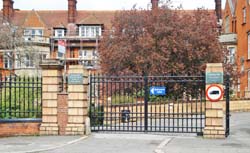
The main gates.
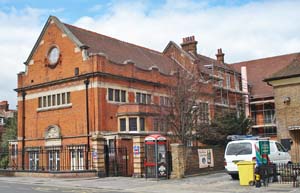
The eastern block and chapel. The chapel was Grade II listed in 1981.
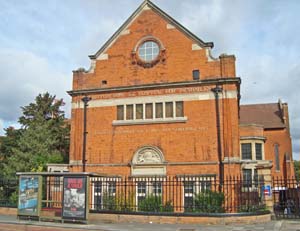
The building bears the legend BRITISH HOME AND HOSPITAL FOR INCURABLES and ENTIRELY DEPENDENT ON VOLUNTARY DONATIONS.
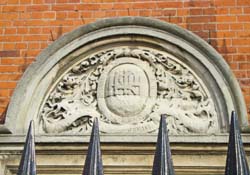
The stylised lettering (? BHH) in stonework has been damaged, but Founded 1861 in still legible.
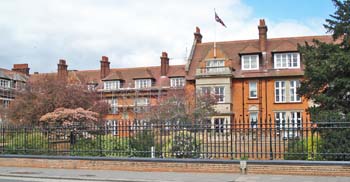
The central blocks.
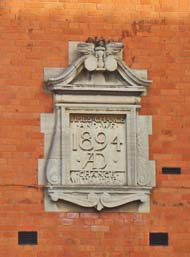
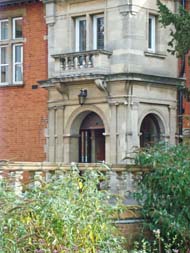
Stonework details

The Queen Alexandra Wing.
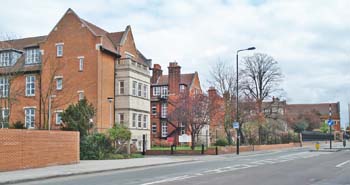
The Home, as seen from the west, along Crown Lane.
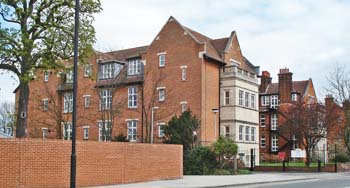
The newest block, built in 1995, blends in with the style of the older blocks.
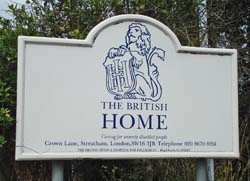
Signage at the driveway on the western side of the Home.
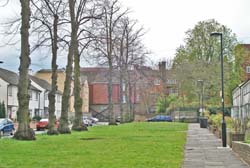
Looking towards the rear of the site along Lindway.
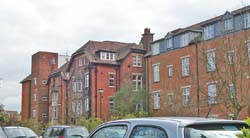
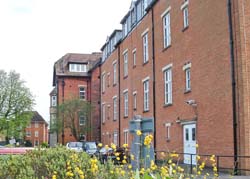
The northern elevation at the rear of the Home.
(Author unstated) 1892 Nursing echoes. The Nursing Record, 14th July, 575.
(Author unstated) 1898 Reflections from a Board Room mirror. Nursing Record and Hospital World, 1st January, 15.
(Author unstated) 1898 Reflections from a Board Room mirror. Nursing Record and Hospital World, 31st December, 538.
(Author unstated) 1899 Coming events. Nursing Record and Hospital World, 27th May, 426.
(Author unstated) 1900 Reflections from a Board Room mirror. Nursing Record and Hospital World, 20th January, 58.
(Author unstated) 1912 Reflections from a Board Room mirror. British Journal of Nursing, 20th July, 54.
(Author unstated) 1912 Reflections from a Board Room mirror. British Journal of Nursing, 26th October, 341.
(Author unstated) 1917 List of the various hospitals treating military cases in the United Kingdom. London, H.M.S.O.
(Author unstated) 1923 Hospital world. British Journal of Nursing, 26th May, 333.
(Author unstated) 1957 The British Home and Hospital for Incurables, Crown Lane, Streatham SW16. London, British Home and Hospital.
Cook GC 2006 The Incurables Movement: an Illustrated History of the British Home. Abingdon, Radcliffe Publishing.
http://hansard.millbanksystems.com
http://landmark.lambeth.gov.uk (1)
http://landmark.lambeth.gov.uk (2)
http://landmark.lambeth.gov.uk (2)
http://landmark.lambeth.gov.uk (2)
http://landmark.lambeth.gov.uk (2)
http://landmark.lambeth.gov.uk (2)
http://landmark.lambeth.gov.uk (2)
www.bl.uk
www.british-history.ac.uk (1)
www.british-history.ac.uk (2)
www.britishhome.org.uk
www.britishlistedbuildings.co.uk
www.flickr.com
www.geograph.org.uk (1)
www.geograph.org.uk (2)
www.geograph.org.uk (3)
www.geograph.org.uk (4)
www.geograph.org.uk (5)
www.geograph.org.uk (6)
Return to home page